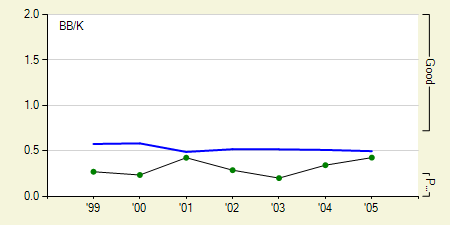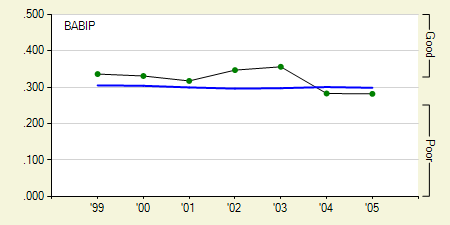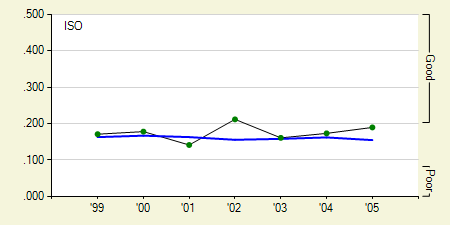Daily Graphing: Jacque Jones
With all talk of the Yankees signing Johnny Damon, it seems like the Cubs signing Jacque Jones to a three year, $16 million contract got lost in the news. Jones is currently a career .280 hitter, and even managed to bat .300 in 2002-2003, but since then has batted just around .250. Despite the recent drop in batting average, he’s continued to show good power, hitting 24 and 23 home runs the past two seasons. Let’s see what’s in store for Jones next season in his new home, Wrigley Field.

If you take a look at his walk to strikeout ratio (BB/K), you’ll see it looks like he reached a career high of .43 in 2005. While this technically true, it’s a bit misleading as 12 of his 51 walks were intentional. In reality, there’s no upward trend here, and he has not improved his patience at the plate.

The main reason for his decrease in batting average has been a drop in his batting average on balls in play (BABIP) the past two seasons. Much of this may be fueled by a correlating decrease in the percentage of line drives he hits. In 2002-2003 he hit around 20% of his balls for line drives (near the league average), but in the past two seasons he’s hit less than 15% of his balls for line drives. That’s the fifth lowest line drive percentage in all of baseball over the past two seasons.

Despite the low percentage of line drives, his isolated power (ISO) has remained pretty decent. What’s most interesting is that over the past four seasons he’s hit between 18% and 23% of his fly balls for home runs (HR/FB). Last season, his HR/FB was 21.7% which puts him in the same category (in HR/FB only) as players such as David Ortiz, Albert Pujols, and Mark Teixeira; players typically thought of as power hitters. One of the main statistical differences between him and these players is that he’s a ground ball hitter. An extremely high 58% of the balls he hits are ground balls, the 3rd highest in baseball.
Moving from Metrodome to Wrigley Field probably won’t have too much of an impact on Jones, but he should be in a more productive lineup which certainly won’t hurt. I think his batting average will recover slightly in 2005, yet considering his walk to strikeout ratio and his line drive percentage, it seems highly unlikely he’ll return to his .300 levels. He does appear to have some untapped power, but as long as he continues to hit a high percentage of ground balls, I’d expect him to continue hitting around 20 home runs a season.